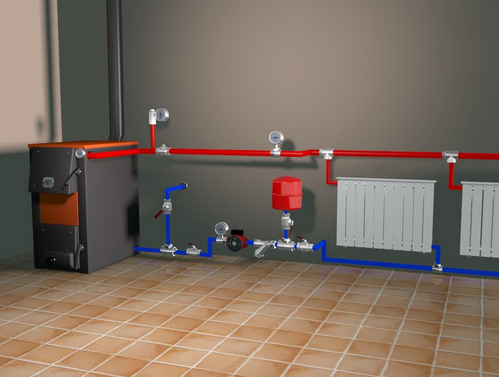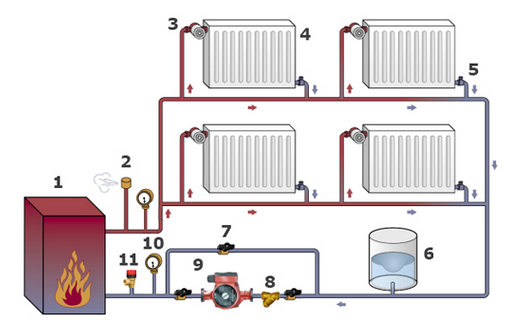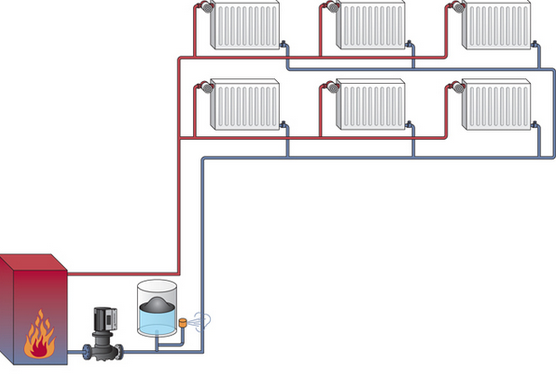The design and arrangement of a heating system in a house can be carried out in a variety of ways. Already at the stage of drafting the project, you should choose the most optimal option, which will help to translate into reality all the owner's ideas, without going beyond the planned budget.
The most financially profitable option is the one-pipe distribution of the heating system. Two-pipe heating distribution can be somewhat more expensive, but the effectiveness of this method is much higher.
Popular heating distribution methods
A fireplace or stove is very often placed in the modern interior of a private house, but they most likely carry a decorative function that emphasizes the individual style of the house, since the main heating load falls on one or two loop heating boilers. The principle of operation of a single-circuit boiler is solely to provide heating of the house, while a double-circuit boiler, in addition to heating the house, can also work as water heating.
Regardless of the type of heating boiler, both a one-pipe wiring diagram and a two-pipe one can be used to equip an individual heating system. Let's consider their main features, and try to figure out what are the advantages and disadvantages of each type.

One-pipe distribution of the heating system
The principle of operation of such a system is very simple: when arranging heating, only one pipe is installed, which creates a vicious circle. This system connects batteries from every room in the house.
There are two ways to equip such a system:
- horizontal;
- vertical.
The horizontal method of arranging a one-pipe heating system with a bottom wiring is more popular, since it has a fairly simple design. A special feature is a special method of laying, in which the installed pipes must have a slight slope so that the coolant can easily circulate throughout the system.
The nuances of laying with the horizontal method arise when the heating is mounted in a multi-storey building. Then, at the entrance to the initial section of the radiator located on the first floor, you need to install a valve, partially blocking which you can create the necessary pressure for the circulation of the coolant on the upper floors.

You can fix this situation in the following ways:
- increase the total number of sections in the radiator, as it moves away from the boiler;
- install special thermostatic valves on the radiators that regulate the supply pressure of the coolant to each radiator;
- install a circular pump that will maintain the pressure at the required level and contribute to the correct distribution of the coolant throughout the network.
A single-pipe heating system in a private house will be optimal for arranging a heating system in a one-story private house with an area of no more than 100m², without the need for additional devices of the "warm floor" type.

Two-pipe distribution of the heating system
The main difference between this type of arrangement of the heating system from the previous one is that each battery is connected to the main pipe of both forward and reverse current. This feature doubles the pipe flow rate. But it is worth noting the positive aspects. The owner of the house can independently regulate the level of heat supply to each radiator. As a result, a pleasant atmosphere can be easily created in each room.
The arrangement of a two-pipe heating system provides for several dignified wiring methods. Let's consider each of them in more detail.

Vertical diagram with bottom wiring
The technological process of installing a two-pipe heating system with bottom wiring includes the following stages:
- A main pipeline is mounted on the floor of the first floor or basement, which originates from the heating boiler.
- Vertical pipes are laid along the main pipe, which ensure the advancement of the coolant to the radiators in the rooms.
- A pipe must be installed for each radiator for the backflow of the already cooled coolant into the heating boiler.
When designing a scheme for a two-pipe heating system with a lower wiring, you must definitely think about how exactly the need for regular air outlet from the pipeline will be provided. As a rule, this requirement is ensured by the installation of an air pipe, an expansion tank and the installation of Mayevsky cranes on all batteries, which are located on the second and third floors of the building.

Horizontal heating system
Arrangement of horizontal wiring of a forced circulation heating system is a very popular way to heat a house.
When installing horizontal heating, several schemes are traditionally used:
- Dead end. The advantage of this option lies in the economical consumption of pipes. The disadvantage is that the length of the circuit is very long and this makes it much more difficult to regulate the operation of the entire system.
- Concurrent water advance. All circulation circuits are of equal length and this helps to adjust the system easily and easily. The disadvantage of this wiring diagram for heating a private house is the high consumption of pipes, which, by their cost, significantly increase the repair budget, and also spoil the interior of the premises.
- Collector or radial distribution of the heating system. Due to the fact that each battery is individually connected to the central heating distribution manifold, it is very easy to ensure an even distribution of heat. The disadvantage, as in the second case, is the very high consumption of materials. But all pipes are mounted in the wall, which does not spoil the interior of the room. To date, this wiring diagram for heating a private house is gaining popularity among developers.
When choosing a wiring diagram, it is important to take into account a lot of factors: the area of the building, types of construction materials, etc.

Conclusion
Designing and arranging the heating system of a private house is an occupation that requires time, knowledge and money. Therefore, in order to avoid mistakes, it is best to turn to professionals in their field for help. After all, correcting shortcomings can be very expensive, so it is better to avoid them from the very beginning.
How to correctly perform an independent two-pipe heating wiring in a private house, we learn in the next video



